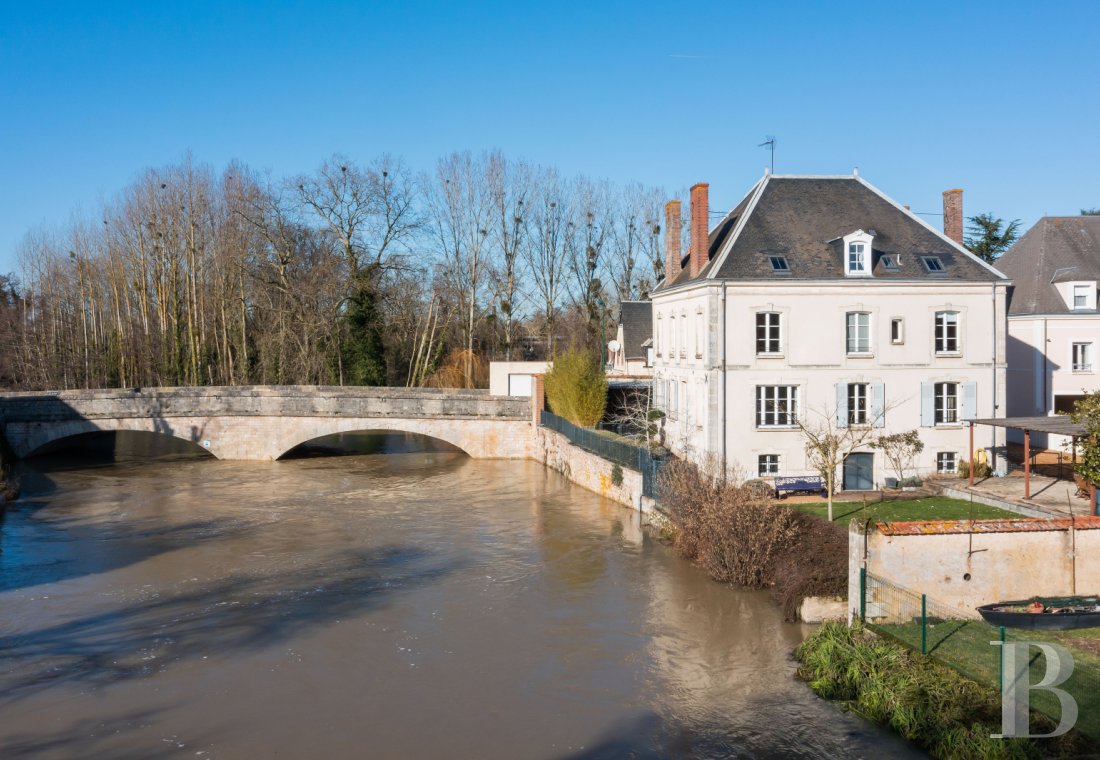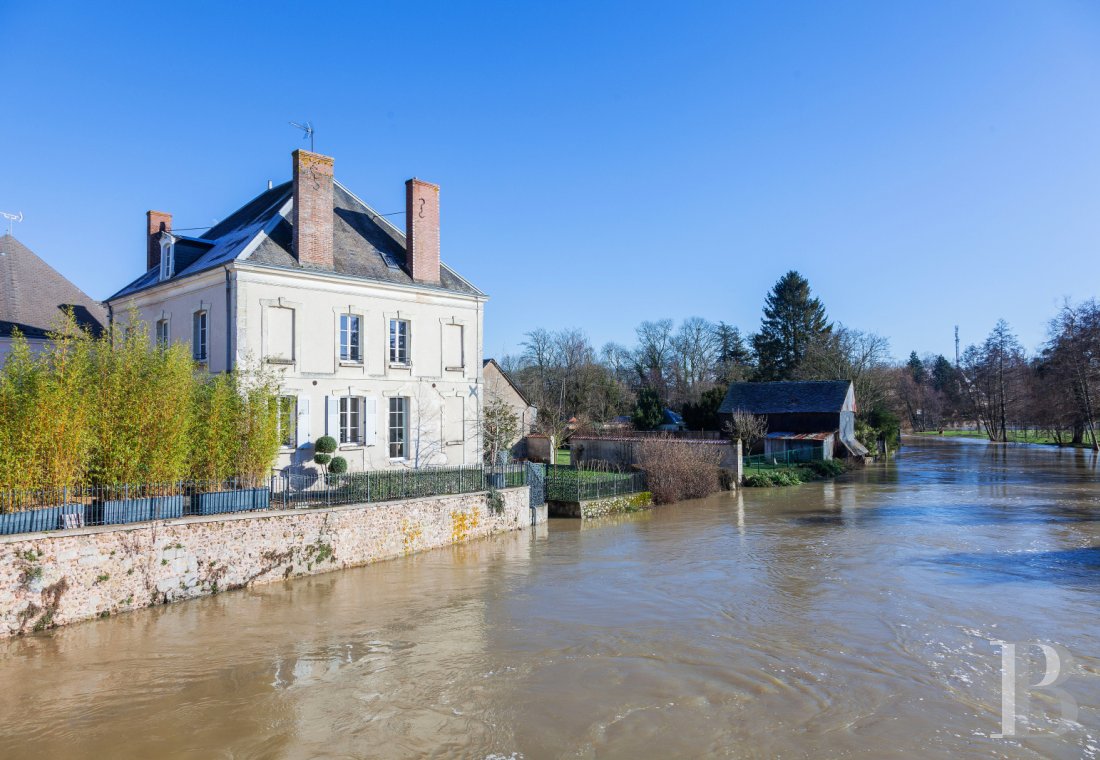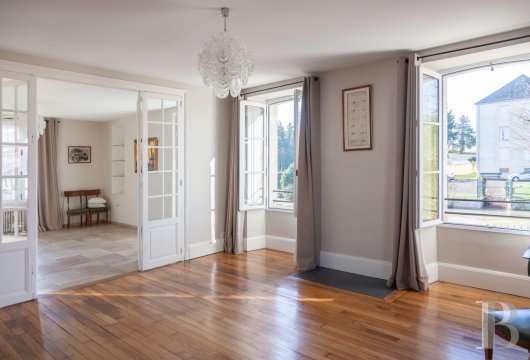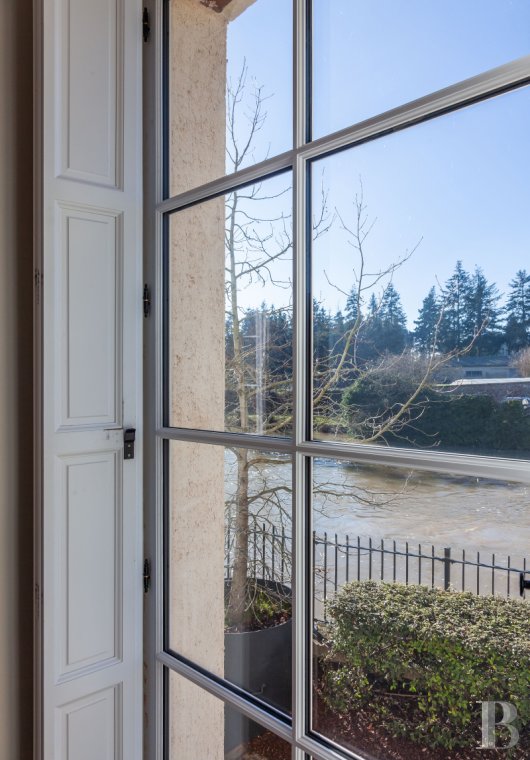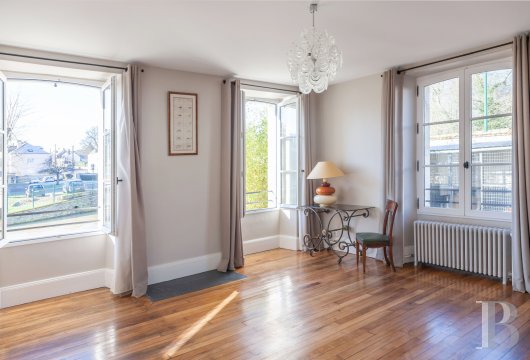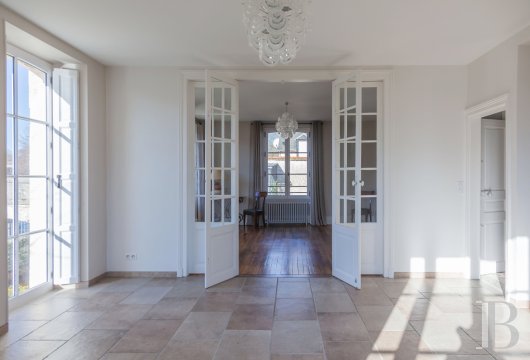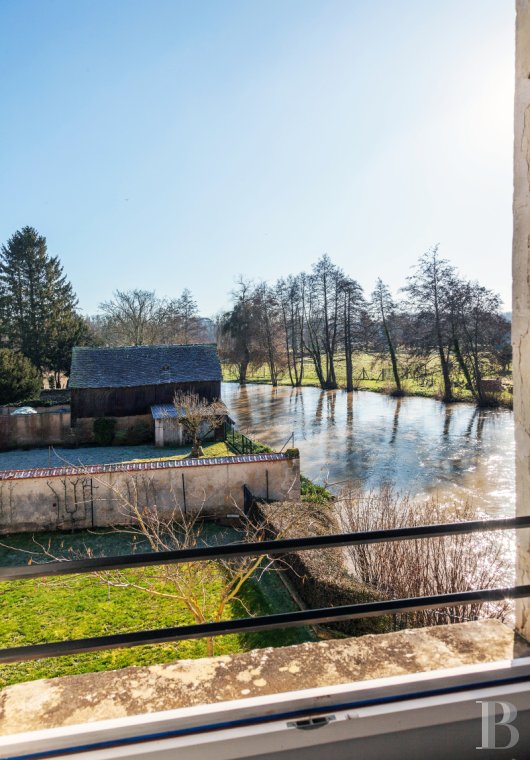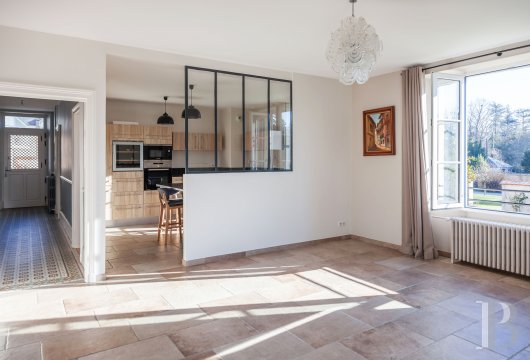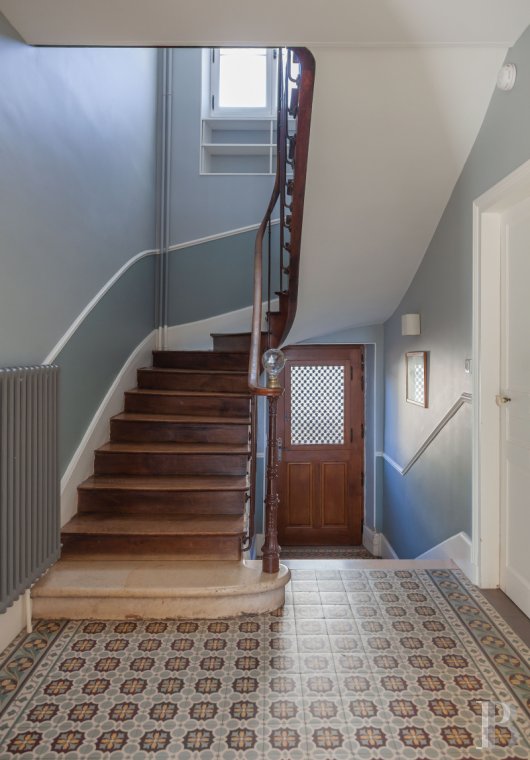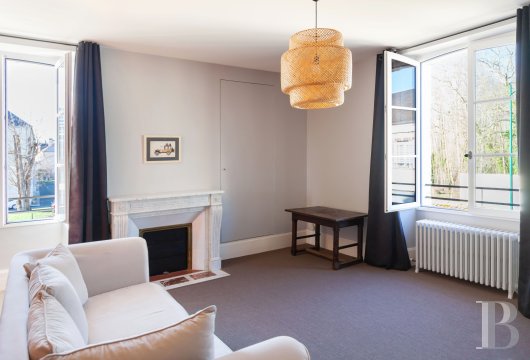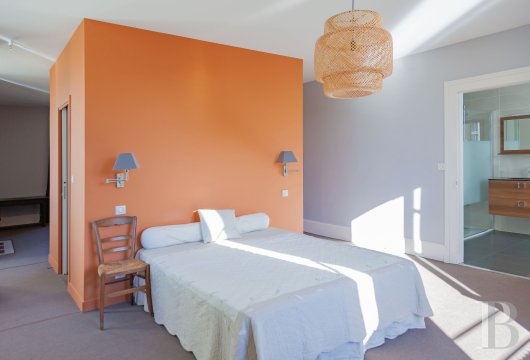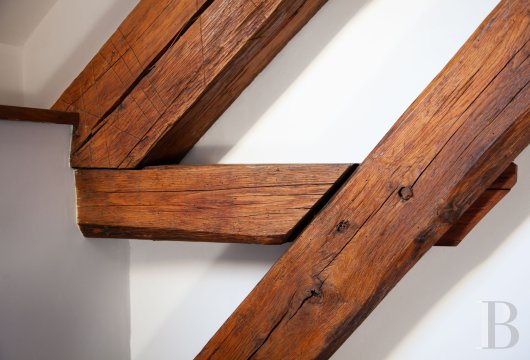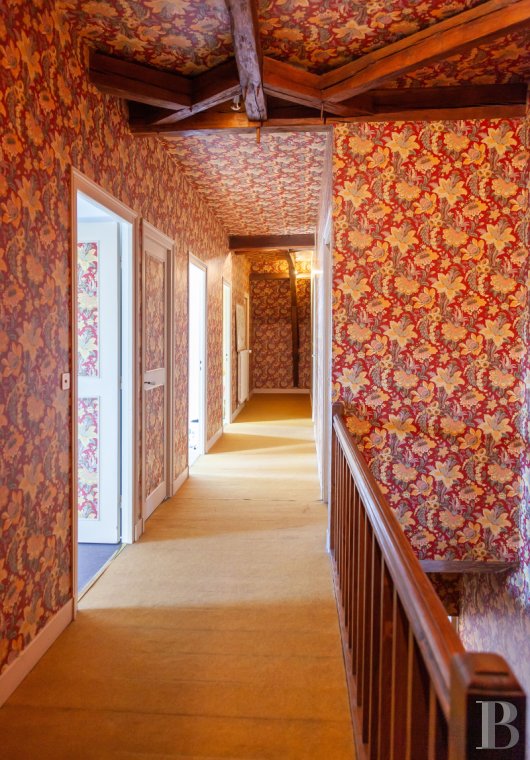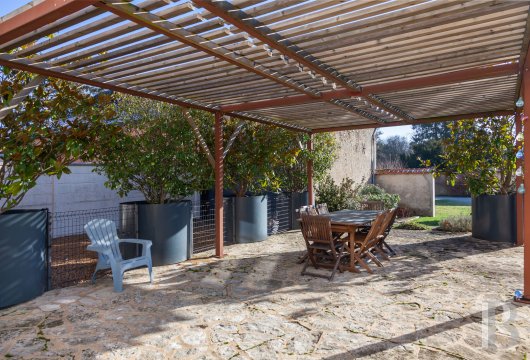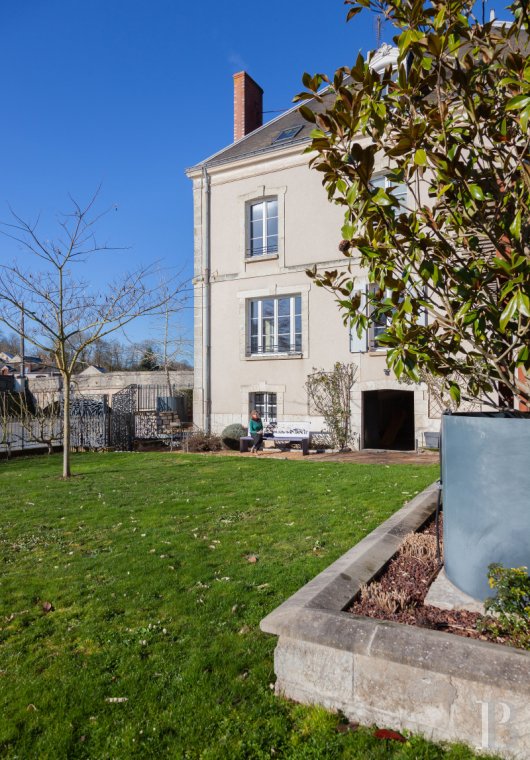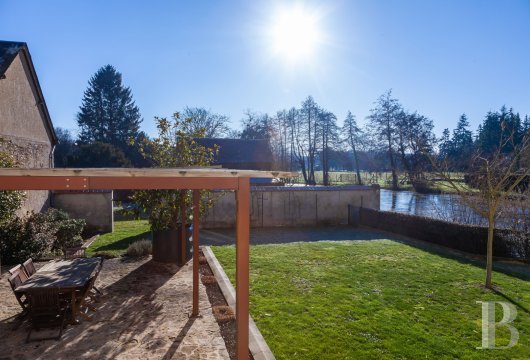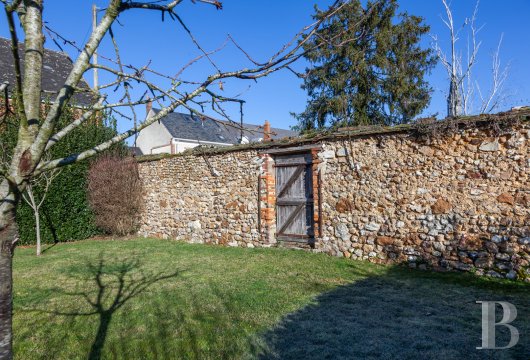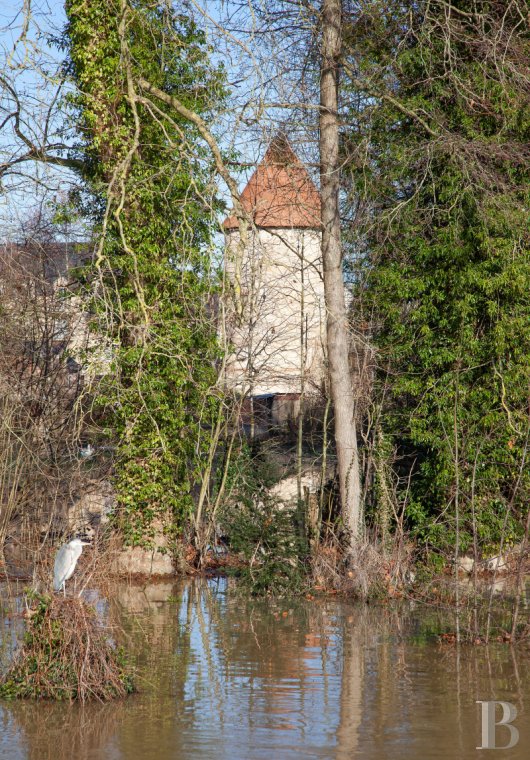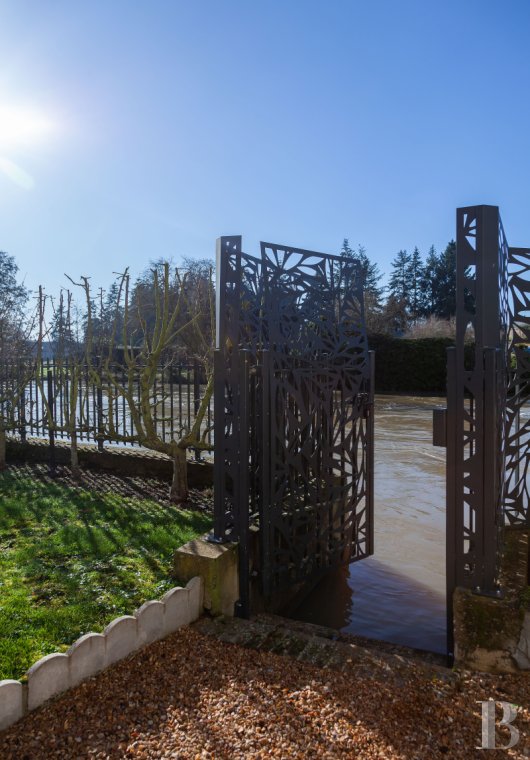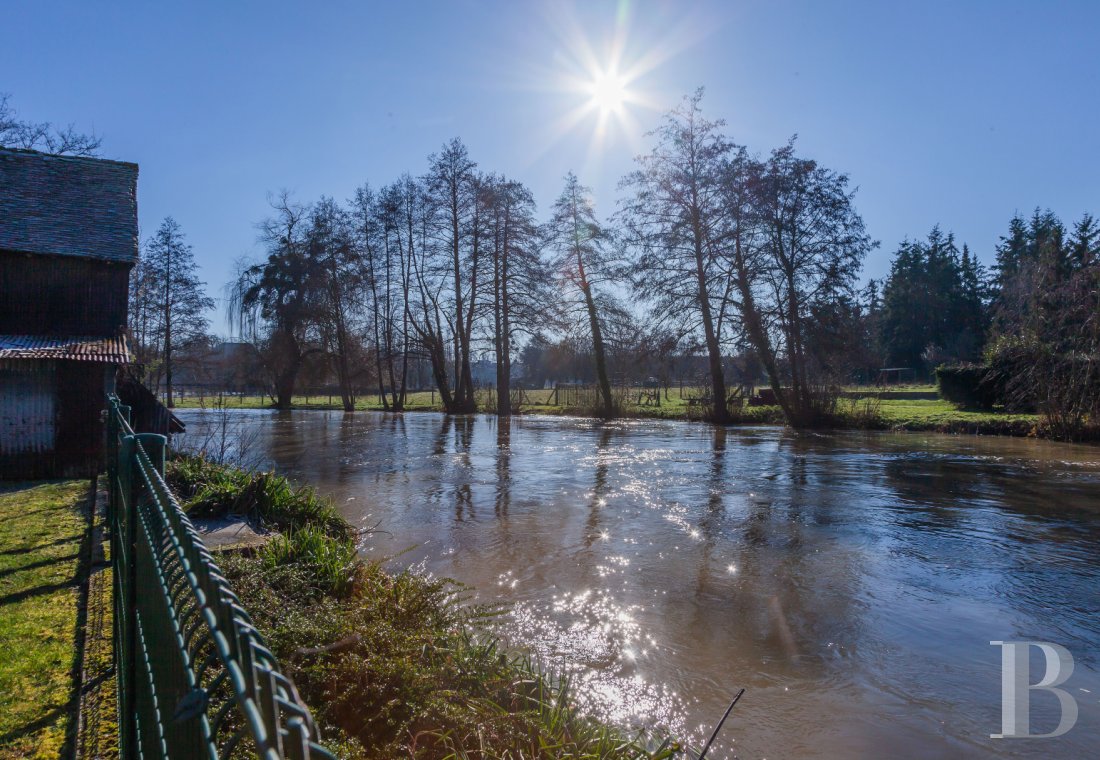Location
An hour and a half from Paris by train or car, 30 km from Chartres and 15 km from Châteaudun, right in the centre of one of the prettiest villages in the Chartres region, crossed by canals and nicknamed the "Little Venice of the Beauce", this is a luminous house in a peaceful setting. The river Loir gently winds its way beneath the windows. All services and amenities can be reached on foot or by bike, including the train station with direct services to Paris-Austerlitz.
Description
The paths on either side of the building provide a passageway to the rear gardens, made up of two distinct sections, partly separated by an old wall covered with espaliered pear trees. Tall, small-paned windows flank the entrance door with a glass panel and grille in the upper section. The facade faithfully echoes the interior layout.
On the north side, a stone step bordered by an old wrought-iron banister suggests that this former mounted police station, which was converted into a post office after the Second World War, may once have had a back entrance not intended for the general public.
The house
According to records, it was built after 1862, and its layout is entirely logical, based on a perfect match between the location of the rooms and their purpose, whether during the day or at night, not forgetting their position, which is so important in this day and age of entertaining and cooking on the southern side of the house. The overall floor plan is rational, ideally suited to contemporary living, with no wasted space but including the necessary transitional spaces, such as landings and corridors. Each room on each floor is a parallelogram. Ceiling heights vary between 2.80 and 2.90 m depending on the storey. The original waxed wooden staircase has been preserved. The old straight strip parquet floors have been restored and sealed where possible. Large, antique-style flagstones have replaced the missing tiles in the kitchen and in one of the reception rooms, which are served by an entrance hall laid with cement tiles inspired by the Belle Epoque period.
The ground floor
Visitors can choose between two entrances. A flight of 5 steps on the left-hand side, bordered by a wrought-iron banister, opens into a kind of lobby of around 10 m², while the front entrance on the garden level leads in a similar way to the intersection of the staircase and the living rooms. The hallway has a coat cupboard to the left and a shower room to the right, lit by a French window with large deep cupboards that conceal utilities. The 14 m² bathroom also serves as a guest lavatory. This is followed by a landing of approx. 7.50 m². On the right, there is an office of around 15 m², which acts as a checkpoint for arrivals and departures. Directly opposite is a passageway leading to the 12 m² kitchen and the sitting room-dining room, separated by a large wooden and glazed accordion door. All of these rooms total a floor area of some 60 m², with 3 large small-paned windows overlooking the gardens and, in the distance, the meadows surrounding the village.
The first floor
The only access to the upper floors is via an old wooden staircase, approximately 1.10 m wide and in perfect condition. A generous landing of around 6 m² serves the various bedrooms. To the right, the master bedroom of around 20 m² is preceded by a family room of around 18 m² with a Transition-style sculpted white marble fireplace and a shower room with walk-in shower of just under 10 m². The family room is separated from the bedroom by a partition containing a professionally designed closet with a sliding door. To the left, a door conceals the staircase to the 2nd floor, and a corridor leads to two bedrooms of around 10 and 12 m², a lavatory of 4 m² and a bathroom with bathtub of over 3 m². This entire floor has been completely refurbished and modernised. The bathrooms are brand new, as are all the double-glazed windows in the house.
The second floor
A staircase with walls covered in old wallpaper leads to the 4 additional bedrooms, 2 of which follow in a row on the garden side, while on the other side, the 12-metre-long corridor with the same floral wallpaper leads to a large, left unrestored double room of approx. 25 m², and another bedroom of approx. 25 m², just before a 2-metre-long wardrobe with accordion doors. The first bedroom, partly under sloping ceilings and painted grey, has been redecorated and is lit by a gabled dormer window added by the owners after obtaining permission from the Bâtiments de France. Next follows a separate 4 m² lavatory adjoining the bathroom, which is also newly fitted and measures around 10 m². 2 bedrooms have new gabled dormer windows, the others have roof windows. At the far end, there is a small room of around 10 m² connected to mains running water, awaiting its next purpose.
The basement
An old wooden staircase leads to a basement with a floor area of around 75 m² paved with original bricks. An arched, solid wood double door opens onto the garden level between two windows positioned at split level. The set of 4 successive rooms form an angle around a central landing and make up a vaulted shelter, the central part of which rises to 1.80 m, laying out quite naturally the path round the floor for those who were lucky to grow tall in their youth. This level is divided into four sections. The first, with a floor area of around 15 m², is a storage area separated from the others by a wall and a door. This is followed by a sort of central corridor, around 3.50 m by 6 m, which leads off to the right into a 20 m² room housing the boilers and water inlet, and to the left into another, taller and slightly larger room.
The entrance courtyard
The 200 m² entrance courtyard is covered with white gravel. A lime-rendered perimeter wall and a solid wrought iron gate hide the property and its inhabitants from the street and prying eyes. Beds of hydrangeas adorn the foundation walls of the house. On the left, next to a recently built kennel, tall bamboo trees, whose bold expansion is limited by the boundaries of their planters, invite visitors to take a path reinforced with railway sleepers to reach the small jetty providing access to the Loir and its boat attached alongside the garden.
The garden
The garden to the rear of the house faces south/south-east and is divided into 2 parts by an ancient wall supporting espalier pear trees. At right angles, a sandstone wall forms an angle with the garage, which is located in a barn belonging to the neighbour. At the meeting point, a slightly raised, large stone terrace overlooks the gravel-lined central lawn that stretches along the banks of the Loir. Lush greenery prevents people from accidentally falling into the water. Beyond the dividing wall, another lawn surrounded by a cob wall topped with mossy interlocking tiles can be used as a play area at the foot of an old metal lean-to. The countryside beyond stretches along the Loir, with its distant meadows and ancient barns.
Our opinion
This building is of good structural quality: square, solid, logical, yet charming with its tall windows, balanced by its perfectly crafted components: evenly proportioned levels, airy openings, a relatively gently pitched slate roof: all of which evokes a mastery of expression that is very French, ultimately since the teachings of Mansart, and which applies here to a village building. Originally an administrative building, it took on the air of a welcoming townhouse in the transitional period at the end of the Second French Empire, heralding the prosperous years of the Belle Époque and the subsequent enrichment of the provinces. The recent renovation of the house has taken account of its distinctive late 19th century past, with cement tiles in the entrance hall, solid wood entrance doors with thick, curved railings at the top, reception rooms on the ground floor and bedrooms upstairs. Everything else has been designed to suit today's tastes: the light flooding into the rooms, the bucolic views from the south-facing windows in the reception rooms and the open-plan kitchen, combined with the overall harmonious, uncluttered feel. The brand-new double-glazed windows, the convenient heating system, the number of bedrooms - 7 - and the unique advantage of access to the Loir and a boat at the end of the garden provide the ideal setting for a large family or a group of friends to relax at weekends in a house close to Paris that is easy to get to and to enjoy on a daily basis. The village is unique in that it is surrounded by navigable waterways. And this is where the pleasures of this house captivate the senses: under the windows and amid the vegetation, the shimmering waves, domesticated but enigmatic, whisper, shiver and sparkle to the rhythm of climatic fluctuations.
Reference 800550
| Land registry surface area | 905 m2 |
| Main building surface area | 300 m2 |
| Number of bedrooms | 9 |
| including refurbished area | 300 m2 |
NB: The above information is not only the result of our visit to the property; it is also based on information provided by the current owner. It is by no means comprehensive or strictly accurate especially where surface areas and construction dates are concerned. We cannot, therefore, be held liable for any misrepresentation.


